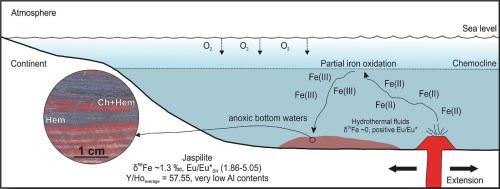Gondwana Research ( IF 6.1 ) Pub Date : 2021-09-22 , DOI: 10.1016/j.gr.2021.09.008 Pedro L.G. Martins 1 , Catarina L.B. Toledo 1 , Adalene M. Silva 1 , Farid Chemale 2 , Corey Archer 3 , Luciano M. de Assis 4

|
One of the most important occurrences of banded iron formation (BIF) worldwide is situated in the Carajás Mineral Province, southeastern Amazonian Craton. The BIFs are jaspilites and are hosted in the Neoarchean (∼2.74 Ga) volcano-sedimentary sequence of the Grão-Pará Group. They are mostly composed of cm-thick intercalations of hematite, jasper, and chert. Their primary textures and structures are still preserved, which make them an ideal archive to evaluate the paleomarine environment. Low abundance of Al2O3 (< 1.0 wt.%) and HFSE (< 1 ppm) for most BIF samples indicate an essentially detritus-free depositional environment. Overall, the rare earth elements and yttrium (REY) patterns show a weak positive lanthanum (La) anomaly, and a pronounced positive europium (Eu) anomaly (Eu/Eu PAAS = 1.86 – 5.05), although the presence of true cerium (Ce) anomaly is not evident. Stratigraphic variations in iron isotope compositions, up to 0.80 ‰ (δ56Fe = +1.10 to +1.90 ‰) over tens to hundreds of meters of stratigraphic section, point to relative changes in the iron isotope composition of Carajás seawater over periods of a few million years. The jaspilites show heterogeneous distribution of Nd isotopic signature throughout the BIF sequence, and rocks from near the basaltic flows/jaspilite contact (type-II) have negative εNd (t) values (–4.97 to –0.90). In contrast, predominantly positive εNd(t) values (–0.84 to +5.40) are common in the remaining samples (type-I). The strongly positive δ56Fe values indicate a low degree of partial oxidation of Fe(II), which, combined with the pronounced positive Eu anomalies and the absence of Ce anomalies, hint towards that the deposition occurred mainly on a deep-sea environment with intense hydrothermal activity under anoxic and suboxic conditions, distal to continental landmasses. Locally, considerable oxygen was probably present in the ancient ocean's water masses, which led to the precipitation of BIFs.
中文翻译:

巴西 Carajás 带状铁地层的化学地层学:新太古代海洋化学记录
世界范围内最重要的带状铁形成 (BIF) 产地之一位于亚马逊克拉通东南部的卡拉加斯矿产省。BIFs 是jaspilites,位于Grão-Pará 群的新太古代(~2.74 Ga)火山-沉积层序中。它们主要由厘米厚的赤铁矿、碧玉和燧石夹层组成。它们的主要纹理和结构仍然保留下来,这使它们成为评估古海洋环境的理想档案。大多数 BIF 样品的低丰度 Al 2 O 3 (< 1.0 wt.%) 和 HFSE (< 1 ppm) 表明沉积环境基本上无碎屑。总体而言,稀土元素和钇 (REY) 模式显示出弱的镧 (La) 正异常和明显的铕 (Eu) 正异常 (Eu/Eu)PAAS = 1.86 – 5.05),尽管真铈 (Ce) 异常的存在并不明显。铁同位素组成的地层变化,在数十至数百米的地层剖面上高达 0.80 ‰(δ 56 Fe = +1.10 至 +1.90 ‰),表明卡拉哈斯海水的铁同位素组成在几个时期内发生了相对变化万年。jaspilites 在整个 BIF 序列中显示出 Nd 同位素特征的不均匀分布,来自玄武岩流/jaspilite 接触(II 型)附近的岩石具有负的 εNd (t) 值(–4.97 至 –0.90)。相比之下,主要为正的 εNd(t) 值(–0.84 至 +5.40)在其余样本(I 类)中很常见。强正δ 56Fe 值表明 Fe(II) 的部分氧化程度较低,结合明显的 Eu 正异常和 Ce 异常的缺失,表明沉积主要发生在缺氧条件下具有强烈热液活动的深海环境中。和低氧条件,远离大陆大陆。在当地,古代海洋的水团中可能存在大量氧气,这导致了 BIF 的沉淀。


























 京公网安备 11010802027423号
京公网安备 11010802027423号